Manual for FOMA SO903i
Precautions for Handling the External Memory
Before using the FOMA terminal
Information on Using the Manual and How to Look up in the Manual
Easy Search/Contents/Safety Precautions Easy Search
Easy Search
Contents
Main Functions of the FOMA SO903i
Making Full Use of SO903i!
Safety Precautions
Handling Precautions
Intellectual Property Right
Supplied and Optional Accessories
Before Using the FOMA Terminal
Part Names and Functions
Using the Displays
About the Sub-display
Selecting the Menu
Using the UIM
Attaching and Removing the Battery Pack
Charging the FOMA Terminal
Checking the Battery Level
Powering On/Off
Setting the Basic Functions
Setting the Date and Time
Notifying the Recipient of Your Phone Number
Checking Your Own Phone Number
Voice/Videophone Call
What is Videophone?
Placing a Voice/Videophone Call
Switching to/from Voice/Videophone Call
Using the Redial/Received Record
Setting the Chaku-moji
Changing the Caller ID Setting ON/OFF for an Individual Call
Placing a Call by Specifying a Condition
Setting a Prefix
Placing an International Call
Placing a Call by Specifying a Sub-address
Setting the Alarm When Reconnecting a Dropped Call
Improving Voice Clarity by Suppressing Background Noise
Talking Hands-free While Driving
Receiving a Voice/Videophone Call
Receiving a Call by Switching to/from Voice/Videophone Call
Pressing a Key on the Keypad to Receive a Call
Setting the Operation for the FOMA Terminal Being Folded during a Call
Using the Low Voice Feature
Putting a Call on Hold during a Call
Putting a Call on Hold
Using the Public Mode (Driving Mode)
Using the Public Mode (Power off)
Checking the Missed Calls
Recording Caller’s Messages When Unable to Answer Calls
Recording a Caller’s Message When Unable to Answer a Call Just Receiving
Playing Back/Deleting a Record Message/Videophone Message/Voice Memo
Using Chara-den
Setting the Videophone Operation
Setting Notice for Switching between Voice and Videophone Calls
PushTalk
What is PushTalk?
Originating a PushTalk Call
Adding a Member during PushTalk Communication
Receiving a PushTalk Call
Saving Data in the PushTalk Phonebook
Originating a PushTalk Call Using the PushTalk Phonebook
Deleting a PushTalk Phonebook Entry
Using the PushTalk Phonebook
Setting the PushTalk Operation
Phonebook
Phonebooks the FOMA Terminal Can Use
Saving an Entry in the FOMA Terminal Phonebook
Saving an Entry in the UIM Phonebook
Saving the Redial/Received Record in the Phonebook
Saving a Group
Displaying the Phonebook
Searching the Phonebook
Setting the Display of the Phonebook
Editing a Phonebook Entry
Deleting a Phonebook Entry
Storing (Restoring/Updating) the Phonebook at the Data Security Service Center
Checking the Number of Entries Saved
Dialing Quickly to Frequently Called Numbers
Using the Data Security Service
Sound/Display/Light Settings
Setting the Ring Tone/Image/Indicator Color for Incoming Call and Mail
Setting the Sounds of the FOMA Terminal
Adjusting the Volume of Caller’s Voice
Adjusting the Volume While Playing Flash Movie
Adjusting the Volume While Running i-αppli Software
Setting the Sound/Indicator While Using the GPS Function
Setting the Poor Signal Quality Alert
Setting Earphone Only for the Ring Tone
Muting the Ring Tone
Changing the Manner Mode Settings
Setting the Stand-by Display
Setting Images for Placing a Call/Sending Mail
Setting the Display for Incoming and Outgoing Calls
Setting the Display for the Sub-display
Setting the Display and Keypad Illumination
Saving Power for the Display
Changing the Appearance of the Menu
Using the Menu Pattern
Informing Missed Call/New Mail with Indicator
Setting the Font Size
Changing the Screen Display to English
Security Settings
Security Codes Used on the FOMA Terminal
Changing the Security Code
Setting the PIN Code
Canceling the PIN Lock
Various Locking Functions
Locking the Keypad to Prevent Unauthorized Use
Restricting Placing/Receiving Calls
Protecting Your Personal Data in the Phonebook, Schedule, etc.
Restricting Dialing from the Keypad
Locking the Keypad to Prevent an Accidental Use
Setting the Display of the Redial/Received Record
Displaying the Data Saved as Secret
Protecting Mail from Unauthorized Access
Specifying Phone Numbers to Accept/Reject Calls
Rejecting Calls with No Caller ID
Muting the Ring Tone for Calls with No Phonebook Entry
Rejecting Calls from Callers with No Phonebook Entry
Using the Data Security Service
Other Measures “For Safety Operation”
Camera
Before Using the Camera
Recording Still Images
Recording Movies
Changing the Camera Settings
Adjusting the Camera during Recording
Setting the Camera Operation
Using the Bar Code Reader
i-mode/i-motion/i-Channel
What is i-mode?
Displaying the i-mode Menu
Displaying Sites
Using Sites
Saving a Site in My Menu
Changing the i-mode Password
Displaying Internet Sites
Saving a Site to Display It Quickly
Saving a Site in the Screen Memo
Obtaining Graphics from a Site/Message
Downloading Data from Related Sites
Using the Phone To/Mail To/Web To/i-αppli To
Setting i-mode
Receiving a Message
Checking a New Message
Displaying a Message
Operating the SSL List
Setting the FirstPass
Changing the Host for Certificate Issue
What is i-motion?
Downloading an i-motion from Sites
Setting Auto Replay of i-motion and i-motion Type to Download
What is i-Channel?
Displaying the i-Channel
Changing the i-Channel Settings
Mail
Mail Function of the FOMATerminal
What is i-mode Mail?
Displaying the Mail Menu
Composing and Sending i-mode Mail
Composing and Sending Deco-mail
Using a Template to Send Mail
File Attachment
Saving i-mode Mail to Send Later
Receiving i-mode Mail
Selecting to Receive i-mode Mail
Checking New i-mode Mail
Replying to i-mode Mail
Forwarding i-mode Mail
Saving the Mail Address/Phone Number in the Phonebook
Playing Back/Saving a File Attachment Received in i-mode Mail
Displaying Received/Sent/Saved Mail
Setting the Mail Function of the FOMA Terminal
Composing and Sending SMS (Short Message Service)
Receiving SMS (Short Message Service)
Checking New SMS (Short Message Service)
Setting SMS (Short Message Service)
i-αppli
What is i-αppli?
Downloading i-αppli from a Site
Running i-αppli
Running i-αppli Automatically
Setting i-αppli for the Stand-by Display
Managing i-αppli
Displaying i-αppli Data in miniSD Memory Card
Using Various i-αppli Functions
Osaifu-Keitai/ToruCa
What is Osaifu-Keitai?
What is the iC transfer service?
Starting an Osaifu-Keitai-compatible i-αppli
What is ToruCa?
Obtaining a ToruCa Card
Displaying a ToruCa Card
Managing ToruCa Cards
Setting the ToruCa Details
Setting Whether to Notify That within the Communication Range
Locking the IC Card Function
GPS Function
What is GPS?
Checking Your Location
Using the GPS-compatible i-αppli
Providing Your Current Location Information upon Request
Notifying Your Current Location Information
Displaying the History of Location Positioning
Using the Location Information from Each Function
Precautions on the Use of GPS Functions
Displaying/Editing/Managing Data
Displaying the Saved Image
Editing Still Images
Playing Back Movie/i-motion
Editing Movies
What is Chara-den?
Playing Back a Melody
External Memory
Displaying Data on the External Memory
About the SubMemory
Displaying Data on the SubMemory
Folder Setup of the External Memory/SubMemory
Data That Can Be Written/Read to and from the External Memory/SubMemory
Saving Data from the FOMA Terminal to the External Memory/SubMemory
Saving Data from the External Memory/SubMemory to the FOMA Terminal
Managing the External Memory/SubMemory
Using the FOMA Terminal with a PC
Copying Data from the FOMA Terminal to the UIM
Copying Data from the UIM to the FOMA Terminal
Managing Data Box
Moving Copyrighted Data
Checking the Memory of the FOMA Terminal
What is the Infrared Communication?
Data That Can Be Sent/Received via Infrared Communication
Receiving Data Using the Infrared Communication
Sending Data Using the Infrared Communication
Using the Infrared Remote Control
What is iC Communication Function?
Receiving Data Using iC Communication
Sending Data Using iC Communication
Displaying PDF Data
Playing Music
What is MUSIC Player?
Transferring Music Data
Downloading Chaku-Uta Full®
Playing Back Music Data
Managing the Playlist
Changing the MUSIC Player Settings
Other Useful Functions
Multiaccess Feature
Multitask Feature
Using the Lifetime Calendar
Starting the Alarm at a Specified Time
Saving Schedules
Performing Frequently Used Functions Quickly
Recording Recipient’s or Your Own Voice
Checking the Call Duration and Charge
Setting the Limit for Alert on the Total Call Charge
Using the Calculator
Using a Memo
Displaying the Settings of Various Functions
Using the Switched Earphone Mic
Receiving a Call Automatically with Earphone
Setting Which Mic to Use
Resetting to the Default Settings
Deleting All Saved Data
List of Reset Items
Network Services
Available Network Services
Using the Voice Mail Service
Using the Call Waiting Service
Using the Call Forwarding Service
Using the Nuisance Call Blocking Service
Using the Caller ID Display Request Service
Using the Dual Network Service
Using the English Guidance Service
Using the Service Numbers
Selecting an Operation for an Incoming Call during a Call
Setting Remote Control
Using the Multi Number Service
Saving a New Service to Use It
Data Communication
About Data Communication
Before Using Data Communication
Preparations and Flow of Data Communication
AT Commands
About the Supplied CD-ROM
Introduction of DoCoMo keitai datalink
Entering Text
About Entering Text
Entering Text
Entering Common Phrases
Entering Pictographs/Symbols
Editing/Saving Common Phrases
Quoting Data from the Phonebook, etc.
Cutting/Copying/Pasting Text
Entering Text Using Kuten Codes
Saving the Frequently Used Kanji Words
Restoring the Default Settings
Using the Downloaded Dictionary
Using the FOMA Terminal Overseas
Overview of International Roaming (WORLD WING)
Services Available Overseas
Before Using the FOMA Terminal Overseas
Placing a Call from Your Overseas Location
Receiving a Call
Setting the Carrier Search Method
Setting the Higher-priority Carrier for Connection
Setting the Display for International Roaming
Starting the Roaming Guidance Service
Rejecting an Incoming Call during Roaming
Using the Network Services during Roaming
Appendix/External Device Interface/Troubleshooting
List of Menus
Preinstalled Data
Characters Assigned to Keys
Special Symbols
Pictographs
Face Marks
Common Phrases
Multiaccess Combinations
Multitask Combinations
Services Available on the FOMA Terminal
Optional and Related Devices
Introduction of Movie Player Software
Troubleshooting
Error Messages
Warranty and After Sales Services
Updating the Software
Protecting Your Mobile Phone from Harmful Data
Specifications
Number of Saved and Protected Data Items
About the Specific Absorption Rate (SAR) of Mobile Phones, etc.
Export Controls and Regulations
Index/Quick Manual
Index
Quick Manual
Don’t forget your FOMA terminal or your manners!
Contacts for Inquiries
Manual for Data Communication (included in the CD-ROM)
About Data Communication
Before Using Data Communication
Preparations and Flow of Data Communication
Connecting the FOMA Terminal to a PC
Installing the Communication Configuration Files (Drivers)
Setting Communication Using the FOMA PC Setup Software
Setting Communication Without the FOMA PC Setup Software
AT Commands
Kuten Code List (included in the CD-ROM)
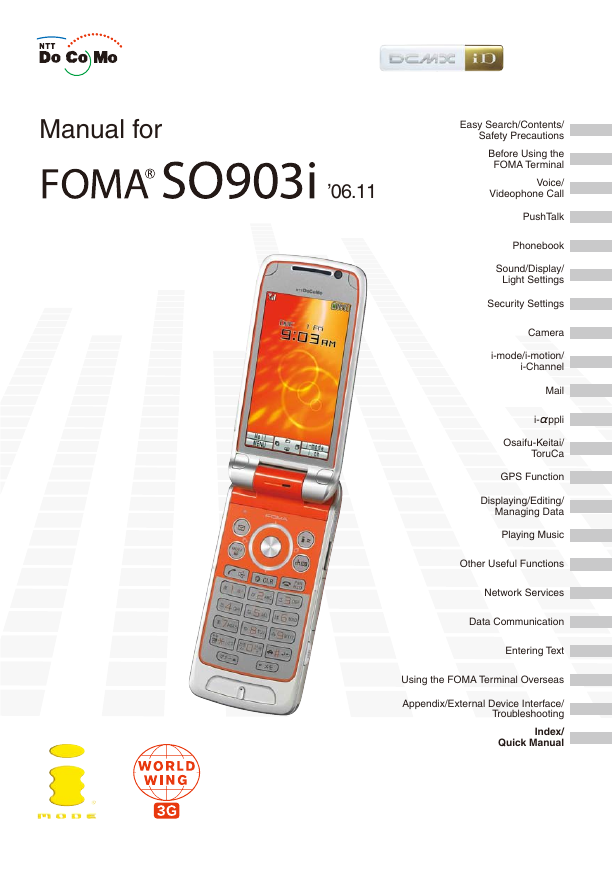
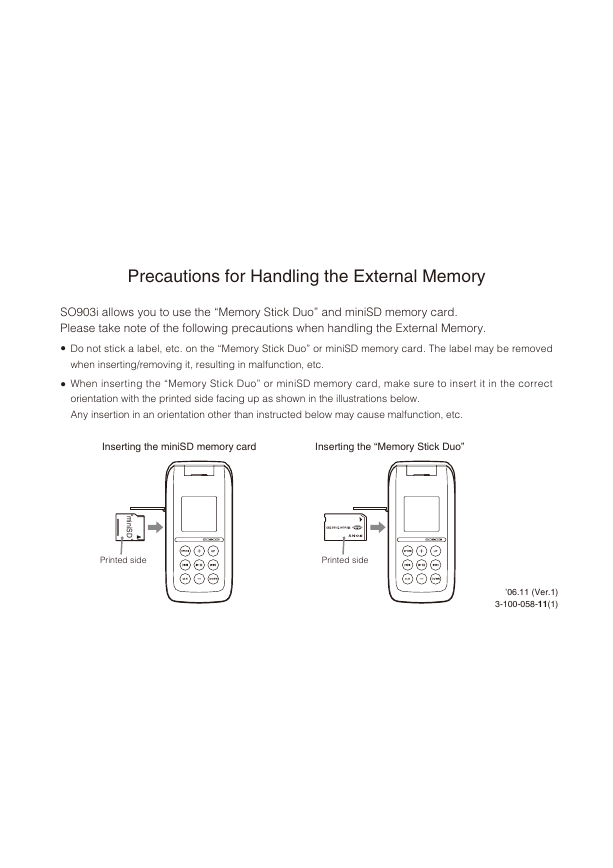
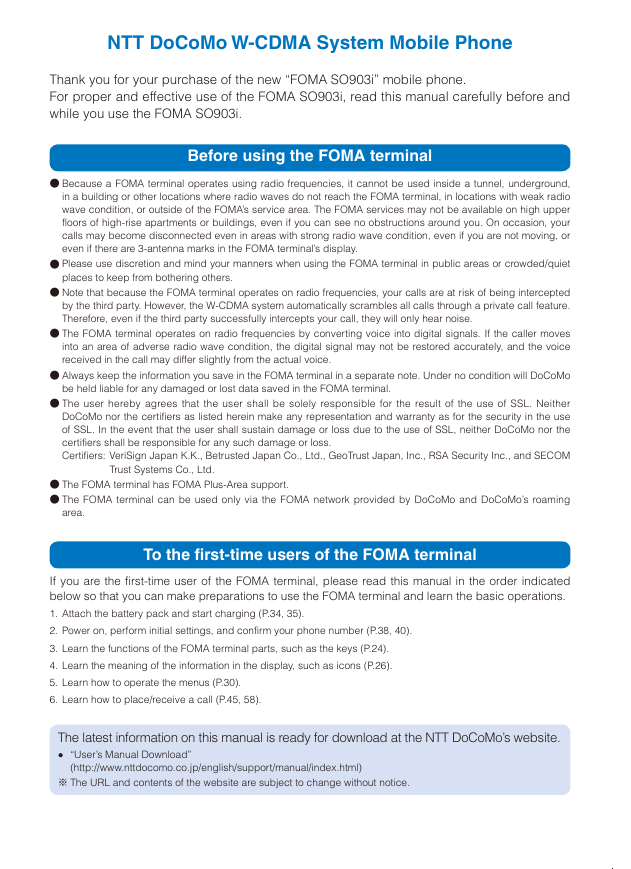
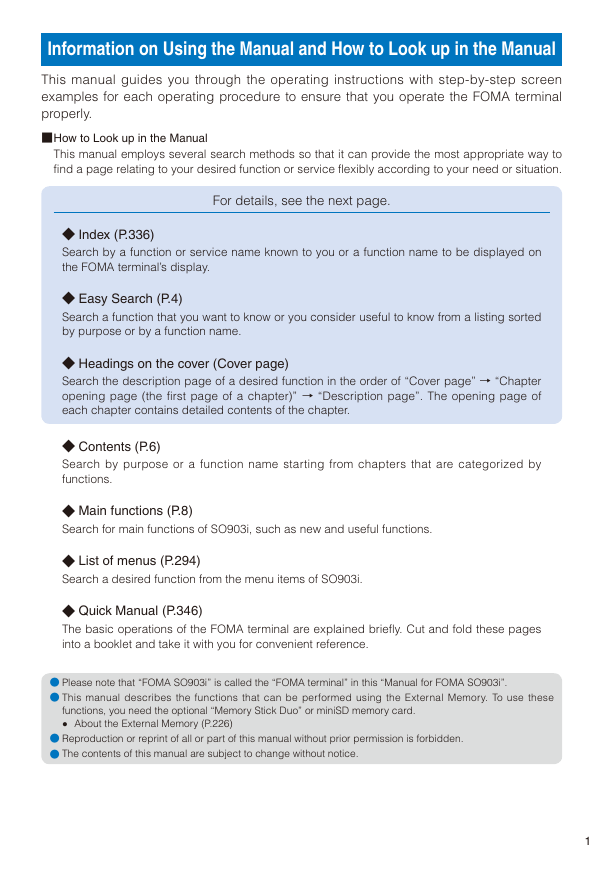
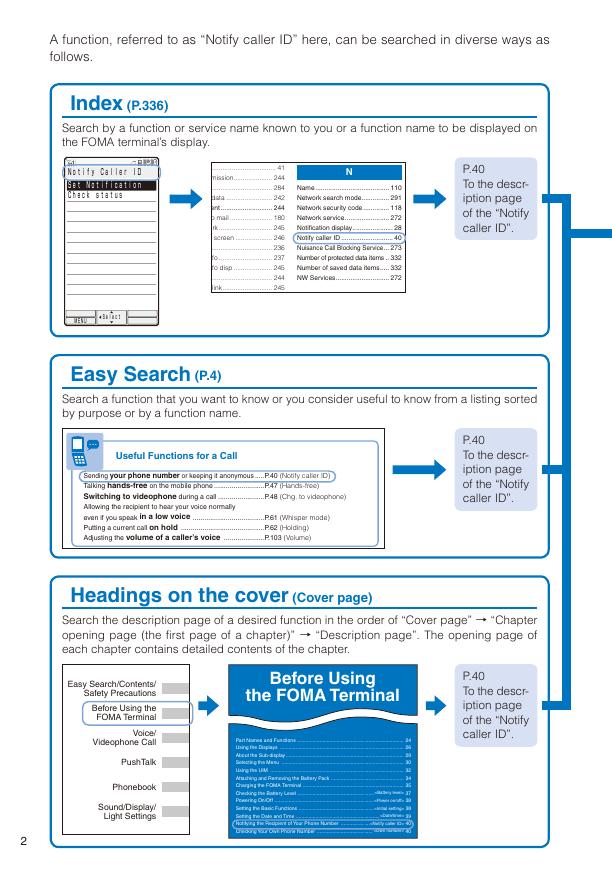
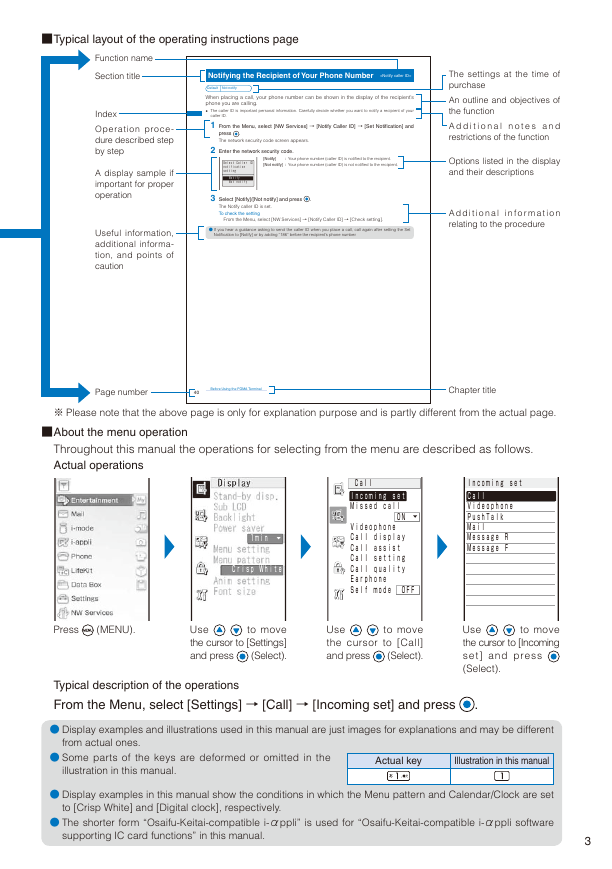
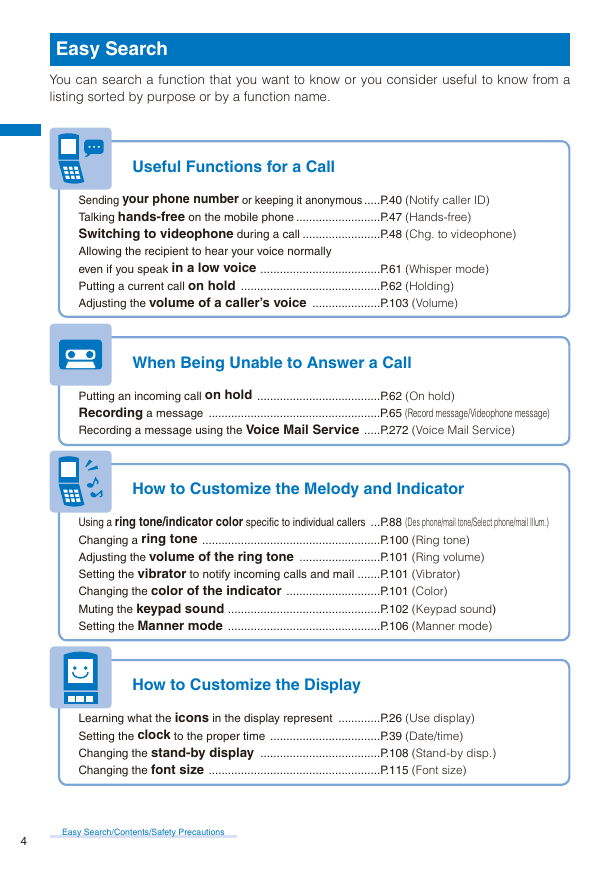
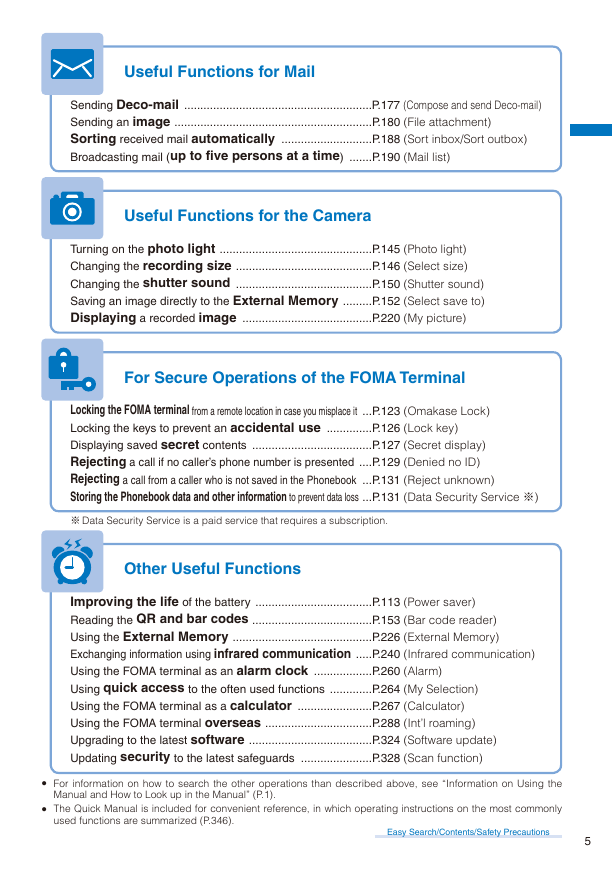








 2023年江西萍乡中考道德与法治真题及答案.doc
2023年江西萍乡中考道德与法治真题及答案.doc 2012年重庆南川中考生物真题及答案.doc
2012年重庆南川中考生物真题及答案.doc 2013年江西师范大学地理学综合及文艺理论基础考研真题.doc
2013年江西师范大学地理学综合及文艺理论基础考研真题.doc 2020年四川甘孜小升初语文真题及答案I卷.doc
2020年四川甘孜小升初语文真题及答案I卷.doc 2020年注册岩土工程师专业基础考试真题及答案.doc
2020年注册岩土工程师专业基础考试真题及答案.doc 2023-2024学年福建省厦门市九年级上学期数学月考试题及答案.doc
2023-2024学年福建省厦门市九年级上学期数学月考试题及答案.doc 2021-2022学年辽宁省沈阳市大东区九年级上学期语文期末试题及答案.doc
2021-2022学年辽宁省沈阳市大东区九年级上学期语文期末试题及答案.doc 2022-2023学年北京东城区初三第一学期物理期末试卷及答案.doc
2022-2023学年北京东城区初三第一学期物理期末试卷及答案.doc 2018上半年江西教师资格初中地理学科知识与教学能力真题及答案.doc
2018上半年江西教师资格初中地理学科知识与教学能力真题及答案.doc 2012年河北国家公务员申论考试真题及答案-省级.doc
2012年河北国家公务员申论考试真题及答案-省级.doc 2020-2021学年江苏省扬州市江都区邵樊片九年级上学期数学第一次质量检测试题及答案.doc
2020-2021学年江苏省扬州市江都区邵樊片九年级上学期数学第一次质量检测试题及答案.doc 2022下半年黑龙江教师资格证中学综合素质真题及答案.doc
2022下半年黑龙江教师资格证中学综合素质真题及答案.doc